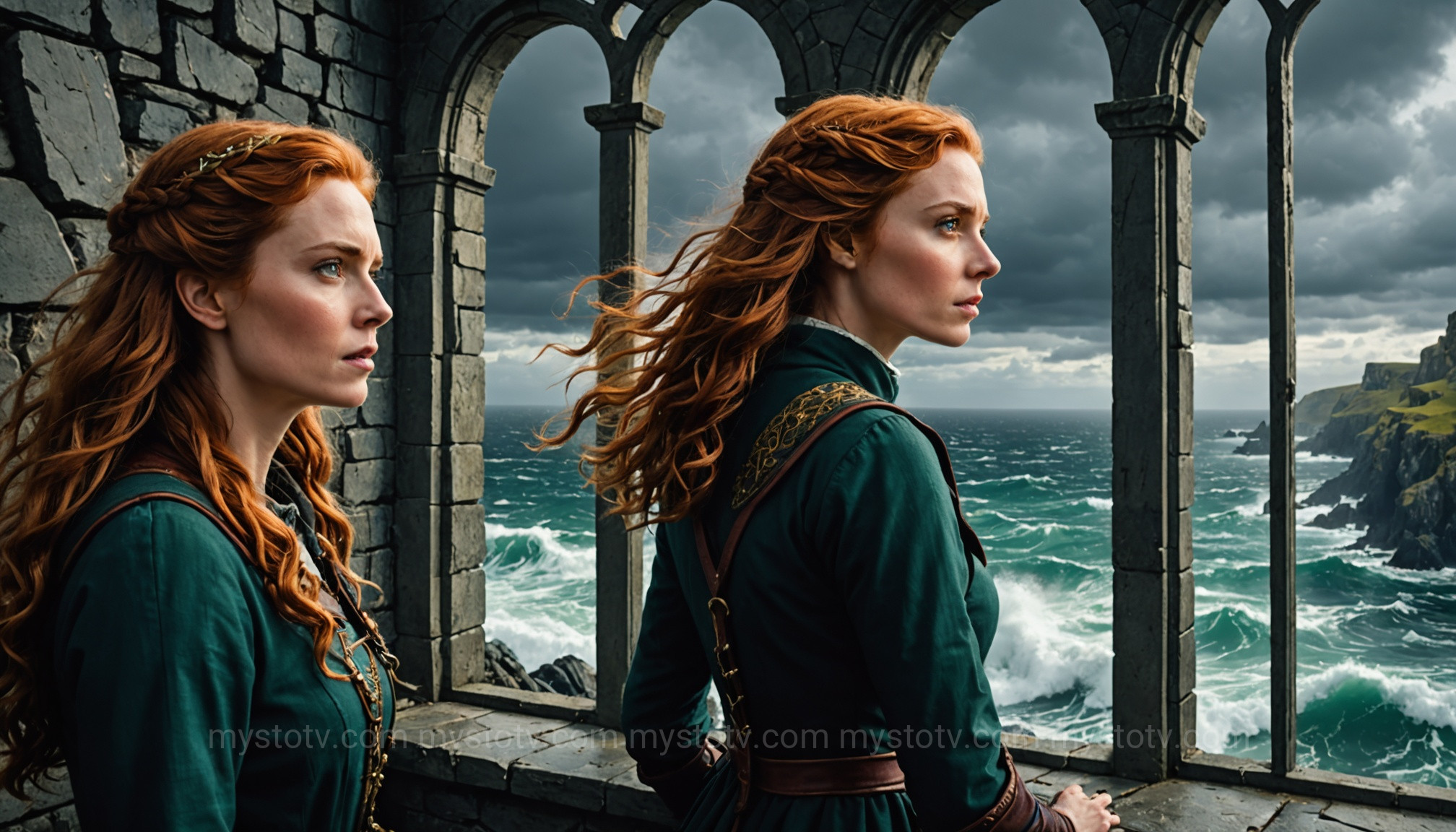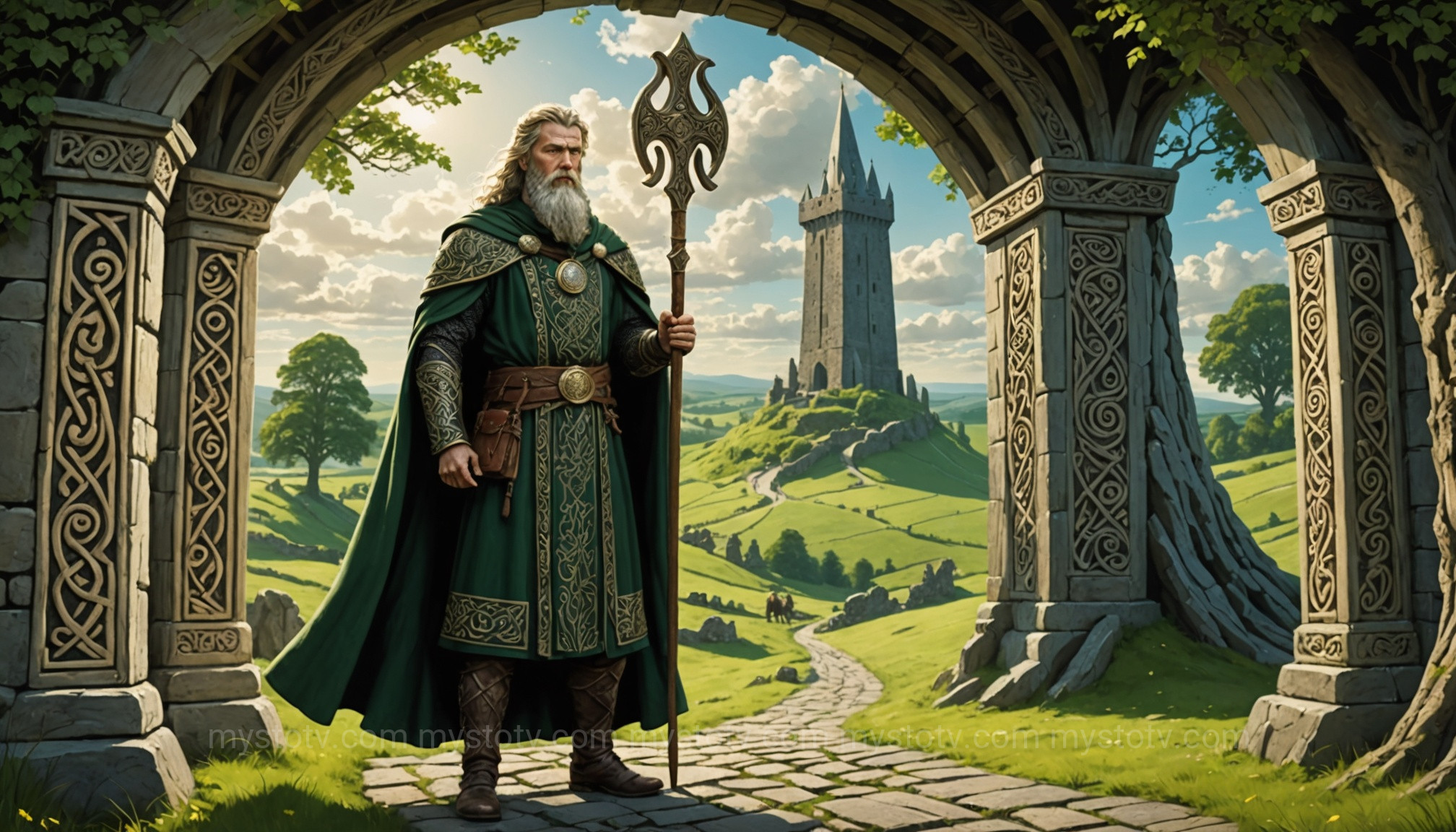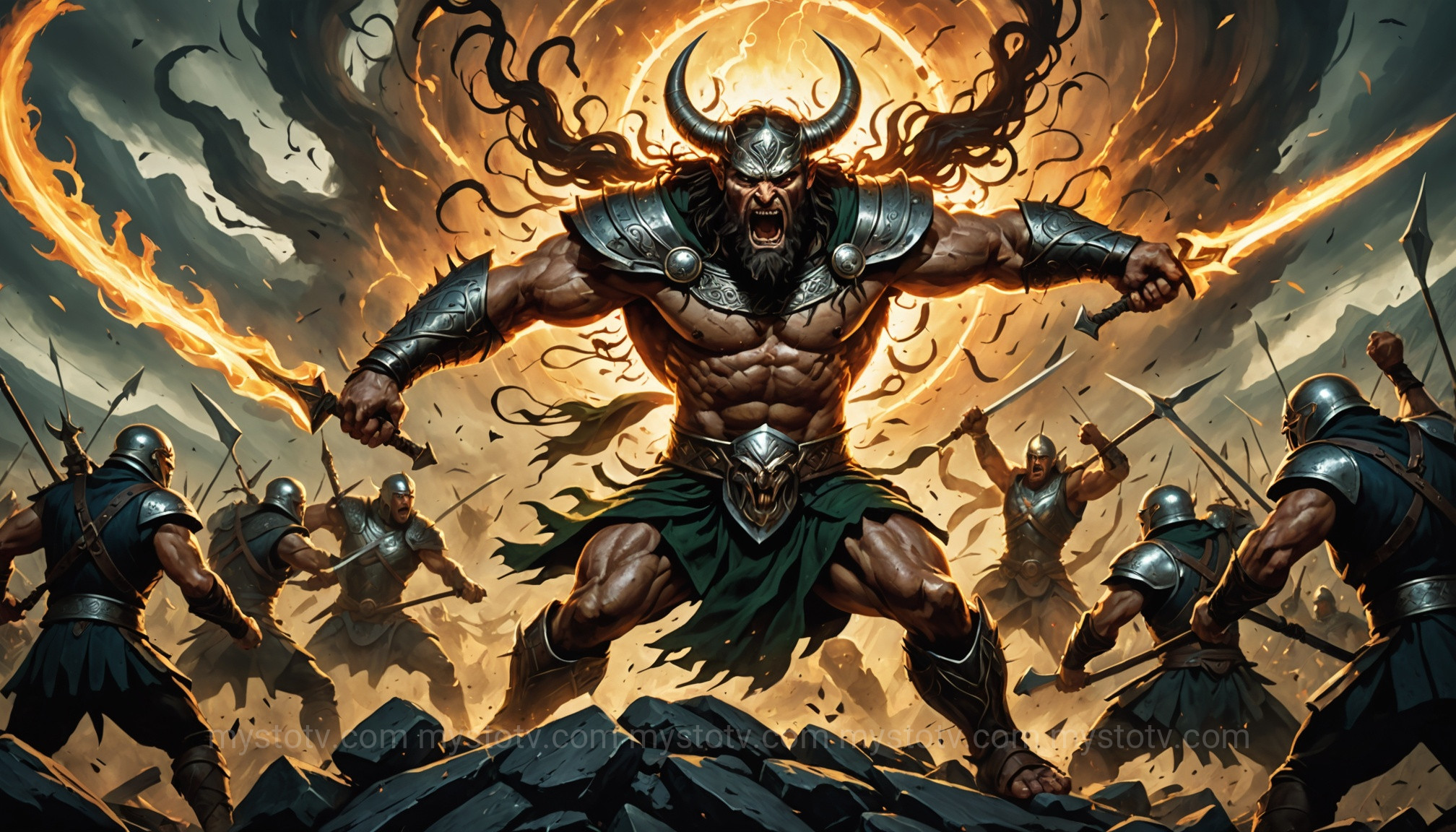Contents
- 1 The Origins and Lineage of the Celtic God Lugh
- 2 Lugh Lámhfhada: Understanding the Epithets of the Celtic God Lugh
- 3 The Pivotal Role of the Celtic God Lugh in the Second Battle of Mag Tuired
- 4 Lughnasadh: The Legacy and Worship of the Celtic God Lugh
- 5 FAQ: Exploring the Celtic God Lugh
- 6 Conclusion: The Enduring Influence of the Celtic God Lugh
- 7 References
The Origins and Lineage of the Celtic God Lugh

To truly understand the celtic god Lugh, one must first look to his bloodline, which is the very source of the central conflict in his story. He is a figure born of two warring tribes: the Tuatha Dé Danann, gods of art, culture, and light, and the Fomorians, primordial beings often associated with the chaotic and destructive forces of nature. This mixed heritage is not a mere footnote; it is the key to his entire identity and destiny.
This union positioned Lugh as a bridge between two worlds, giving him a unique perspective and, ultimately, the legitimacy to challenge both sides. His story is an analysis of identity, showing how one can draw strength from a divided heritage rather than be weakened by it. He embodies the synthesis of civilization (Tuatha Dé) and raw power (Fomorian), a combination that makes him the perfect hero to bring order to a fractured cosmos.
A Prophecy of Vengeance and Destiny
Lugh's birth was foretold in a dramatic prophecy. His maternal grandfather was the fearsome Fomorian tyrant, Balor of the Evil Eye, whose single gaze could bring death and destruction. A druid warned Balor that he would be killed by his own grandson. Terrified, Balor imprisoned his only daughter, Eithne, in a high tower on Tory Island to prevent her from ever meeting a man. However, fate cannot be so easily cheated. Cian, a warrior of the Tuatha Dé Danann whose magical cow was stolen by Balor, sought revenge. With the help of the druidess Biróg, he gained access to the tower, and from this union, Lugh was conceived. When Balor discovered the newborn, he ordered the infant to be drowned, but Biróg intervened once more, saving the child and setting him on his destined path.
Fostered by Gods and Queens
In ancient Irish society, fosterage was a critical institution for building alliances and educating the young elite. The young celtic god Lugh had a particularly auspicious upbringing. He was given into the care of two powerful figures: Tailtiu, the last queen of the Fir Bolg, and Manannán mac Lir, the enigmatic god of the sea. Tailtiu, his foster-mother, raised him on a plane she cleared for agriculture, teaching him the arts of the land, athletics, and governance. Manannán, his foster-father, taught him the secrets of the sea, magic, and the ways of the Otherworld. This diverse education, provided by figures from different tribes and realms, is presented as the source of his encyclopedic knowledge and skill set, making him a living embodiment of collective Irish wisdom.
Lugh Lámhfhada: Understanding the Epithets of the Celtic God Lugh

The many names and titles attributed to the celtic god Lugh are not just honorifics; they are windows into his character and function within the pantheon. Each epithet highlights a different facet of his mastery, painting a complete picture of a deity who represented the pinnacle of Celtic ideals. Analyzing these names reveals what the ancient Irish valued most: skill, far-reaching influence, and comprehensive knowledge.
Lugh Lámhfhada - The Long Arm
Perhaps his most famous epithet, Lámhfhada (pronounced 'Law-vaw-da') translates to "of the Long Arm" or "of the Long Hand." On a literal level, this refers to his incredible prowess as a warrior, specifically his skill with ranged weapons like the spear and the sling. It was with a sling that he famously defeated Balor. However, the interpretation extends far beyond physical reach. Metaphorically, the "Long Arm" signifies his extensive power and influence. His authority reached across all of Ireland, and his commands had weight and consequence. It is the name of a strategist and a far-seeing king whose plans and power could touch anyone, anywhere. It speaks to his role as a sovereign ruler whose reach is absolute.
Ildánach - The Master of All Arts
This title gets to the very heart of what makes the celtic god Lugh so unique. It translates as "Master of All Arts" or "All-Skilled." The story that best illustrates this is his arrival at the Hill of Tara, the seat of the High King of the Tuatha Dé Danann. When he sought entry, the gatekeeper told him that no one could enter without a specific skill to offer the king—a smith, a wright, a champion, a harper, a poet, a historian, a sorcerer. To each proclamation, Lugh replied that he was already a master of that art. When the gatekeeper scoffed, Lugh issued a final challenge: "Ask your king if he has any one man who possesses all of these arts. If he does, I will not need to enter Tara." No such man existed, and Lugh was welcomed in, earning the name Ildánach.
This wasn't just arrogance; it was a statement of a new kind of divinity. While other gods specialized, Lugh embodied the totality of societal function. He was a microcosm of a complete and thriving civilization, a crucial analysis of the qualities required for ideal leadership.
Samildánach - The Equally Skilled in Many Arts
A subtle but important variation of Ildánach, this epithet emphasizes the *quality* of his skill. He wasn't simply a jack-of-all-trades; he was a true master in every single discipline he professed. The term suggests an equal and profound level of competence across the board. The analysis here points to an ideal of holistic excellence. To the Celts, a true leader, a true hero, did not just delegate—they understood and could perform every essential task of their society to the highest standard. This made the celtic god Lugh the ultimate embodiment of competence and the rightful leader of the gods.
The Pivotal Role of the Celtic God Lugh in the Second Battle of Mag Tuired

The Second Battle of Mag Tuired (Cath Maige Tuired) is the central epic of the Irish Mythological Cycle, and it is the stage upon which the celtic god Lugh proves his worth and claims his destiny. His role in this conflict is an object lesson in leadership, strategy, and the power of competence over brute force or simple birthright. It is here that he transitions from a gifted outsider to the savior of his people.
The Tyranny of the Fomorians
Before Lugh's arrival, the Tuatha Dé Danann were languishing under the oppressive rule of the Fomorians. Their king, Nuada, had lost his arm in a previous battle and was deemed unfit to rule due to the blemish. They were forced to install Bres, a half-Fomorian king, who proved to be a greedy and dishonorable tyrant. He imposed crippling taxes on the Tuatha Dé, forcing their greatest champions and craftsmen into servitude. It was a dark time of humiliation and decay, setting the perfect stage for a hero's arrival.
Lugh's Rise to Leadership
After gaining entry to Tara by proving his mastery of all arts (as detailed in the story of the Ildánach), Lugh amazed the court. King Nuada, now restored with a magical silver arm, saw in Lugh a leader of unparalleled potential. Recognizing that Lugh's collective skill surpassed any single individual's, Nuada wisely ceded command of the Tuatha Dé Danann to him for the coming war. Lugh spent years preparing the Tuatha Dé, organizing their armies, rallying their smiths and magicians, and devising brilliant strategies. His leadership was based on a comprehensive understanding of every aspect of warfare, from crafting weapons to inspiring morale, a clear demonstration of the epithets that defined him.
The Defeat of Balor of the Evil Eye
The climax of the battle and of Lugh's personal story was his confrontation with his grandfather, Balor. As the Fomorian forces began to overwhelm the Tuatha Dé, Balor prepared to open his devastating eye, which required four soldiers to lift the eyelid. He had slain King Nuada moments before. Just as the eye opened, Lugh cast a stone from his sling (or in some versions, threw a spear) with such force and accuracy that it drove Balor's eye out the back of his head, turning its destructive power against the Fomorian army itself. This single act fulfilled the prophecy, shattered the Fomorian leadership, and secured a decisive victory for the Tuatha Dé Danann. It was a symbolic victory of skill, light, and ingenuity over blind, destructive power.
Lughnasadh: The Legacy and Worship of the Celtic God Lugh
The influence of the celtic god Lugh extends beyond myth and into the very fabric of the Celtic calendar and cultural life. His most enduring legacy is the harvest festival of Lughnasadh (Lúnasa in modern Irish), traditionally celebrated on August 1st. An analysis of this festival reveals a different side of Lugh—not just a warrior and king, but a god of community, prosperity, and the social order that underpins civilization.
The Funeral Games for Tailtiu
According to myth, Lugh established the festival not for himself, but in honor of his foster-mother, Tailtiu. She was a queen of the Fir Bolg who had died from exhaustion after clearing the forests of Ireland to create plains for agriculture. To honor her sacrifice, which made farming and civilization possible, Lugh inaugurated an annual gathering with athletic contests, feasting, and trade. This origin story frames Lugh as a god who understands and honors the hard work and sacrifice necessary for society to flourish. He links the success of the harvest directly to communal memory and celebration.
From Ancient Festival to Modern Echoes
Historically, Lughnasadh was one of the four great seasonal festivals of the Celtic year. It was a time when tribes would gather at prominent hills or landmarks for a great assembly (an oenach). These gatherings included horse races, athletic games (reminiscent of the Olympic Games), legal proceedings, matchmaking (including trial marriages that lasted a year and a day), and celebrating the first fruits of the harvest. Though the direct worship of the celtic god Lugh has faded, the spirit of Lughnasadh persists in many local fairs, harvest festivals, and climbing pilgrimages (like the Reek Sunday pilgrimage up Croagh Patrick) that still take place in Ireland and other Celtic nations around the beginning of August.
FAQ: Exploring the Celtic God Lugh
- Is Lugh a sun god?
- This is a common point of debate. While Lugh is heavily associated with light, brightness, and skill—and his name is often linked to the Proto-Indo-European word for "light"—he is not a straightforward sun deity in the way of Apollo or Ra. He is more accurately described as a god of light and illumination in a broader sense, representing intellectual brilliance, artistic genius, and the "light" of civilization. His festival, Lughnasadh, is a harvest festival, not a solstice or equinox celebration, further distinguishing him from a purely solar role.
- What are the magical weapons of the celtic god Lugh?
- Lugh possessed several famed weapons, often counted among the Four Treasures of the Tuatha Dé Danann. His primary weapon was the Spear of Lugh, also known as the "Slaughterer." It was a living weapon that thirsted for blood so fiercely it had to be kept in a cauldron of sleeping draughts to keep it from flying from its owner's hand. He was also, of course, a master of the sling, the humble weapon he used to slay the mighty Balor. Some tales also associate him with Manannán's magical sword, Fragarach ("The Answerer").
- How is Lugh related to the hero Cú Chulainn?
- In the Ulster Cycle of Irish mythology, the celtic god Lugh appears as the divine father of the great hero Cú Chulainn. While Cú Chulainn's earthly father is Sualtam mac Róich, Lugh appears to his mother, Deichtire, and fathers the child. Lugh later appears to Cú Chulainn on the battlefield of the Cattle Raid of Cooley (Táin Bó Cúailnge), healing his wounds and fighting in his stead, reinforcing his role as a divine protector and progenitor of Ireland's greatest warrior.
Conclusion: The Enduring Influence of the Celtic God Lugh
From his fated birth to his leadership in a cosmic war and his lasting cultural legacy, the celtic god Lugh stands as one of the most compelling and sophisticated figures in all of world mythology. He is far more than a simple warrior god. He is the Ildánach, the Master of All Arts, a divine embodiment of skill, intelligence, and the ideal of holistic competence. His story is a powerful analysis of leadership, demonstrating that true authority comes not from birthright or brute strength alone, but from a mastery of the skills that build and protect a civilization.
Lugh represents the triumph of light over darkness, order over chaos, and skill over tyranny. Whether seen in the myths of his victory over Balor, the communal joy of his festival Lughnasadh, or his echoes in modern fantasy, the celtic god Lugh remains a potent symbol of human potential and the timeless pursuit of excellence in all its forms.
References
- Cross, Tom Peete, and Clark Harris Slover, eds. Ancient Irish Tales. Barnes & Noble, 1996 (originally published 1936).
- MacKillop, James. Dictionary of Celtic Mythology. Oxford University Press, 1998.
- Squire, Charles. Celtic Myth and Legend. Dover Publications, 2003.
- The Second Battle of Mag Tuired. Trans. Elizabeth A. Gray. Irish Texts Society. https://celt.ucc.ie/published/T300010/